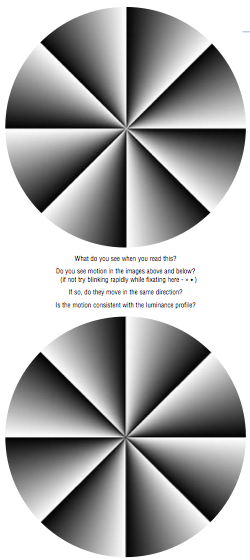Difference between revisions of "Peripheral drift illusion" - New World Encyclopedia
(Started) |
({{Contracted}}) |
||
| Line 1: | Line 1: | ||
| − | {{Claimed}}{{Started}} | + | {{Claimed}}{{Started}}{{Contracted}} |
[[Category:Politics and social sciences]] | [[Category:Politics and social sciences]] | ||
[[Category:Psychology]] | [[Category:Psychology]] | ||
Revision as of 16:32, 17 September 2007
The peripheral drift illusion (PDI) refers to a motion illusion generated by the presentation of a sawtooth luminance grating in the visual periphery. This illusion was first described by Faubert and Herbert (1999), although a similar effect called the "escalator illusion" was reported by Fraser and Wilcox (1979). A variant of the PDI was created by Kitaoka and Ashida (2003) who took the continuous sawtooth luminance change, and reversed the intermediate greys. Kitaoka has created numerous variants of the PDI, and one called "rotating snakes" has become very popular. The latter demonstration has kindled great interest in the PDI.
The illusion is easily seen when fixating off to the side, and then blinking as fast as possible. Most observers see the illusion easily when reading text with the illusion figure in the periphery. Motion is consistently perceived in a dark-to-light direction, so the two circles to the right should spin in opposite directions.
Two recent papers have been published examining the neural mechanisms involved in seeing the PDI (Backus & Oruç, 2005; Conway et al., 2005). Faubert and Herbert (1999) suggested the illusion was based on temporal differences in luminance processing producing a signal that tricks the motion system. Both of the recent articles are broadly consistent with those ideas, although contrast appears to be an important factor (Backus & Oruç, 2005).
ReferencesISBN links support NWE through referral fees
- Faubert, J. & Herbert, A. M. (1999). The peripheral drift illusion: A motion illusion in the visual periphery. Perception, 28, 617 - 622.
- Fraser, A., Wilcox, K. J. (1979). Perception of illusory movement. Nature, 281, 565 - 566.
- Kitaoka. A., Ashida. H. (2003). Phenomenal characteristics of the peripheral drift illusion. Vision, 15, 261-262.
- Backus, B. T. & Oruç, İ. (2005). Illusory motion from change over time in the response to contrast and luminance. Journal of Vision, 5(11), 1055-1069, [1], doi:10.1167/5.11.10.
- Conway, B. R., Kitaoka, A., Yazdanbakhsh, A., Pack, C. C., Livingstone, M. S. (2005). Neural basis for a powerful static motion illusion. Journal of Neuroscience, 25, 5651 - 5656.
External links
- Rotating snakes at Akiyoshi's illusion pages
- Rotating rings at Sarcone's optical illusion pattern page
Credits
New World Encyclopedia writers and editors rewrote and completed the Wikipedia article in accordance with New World Encyclopedia standards. This article abides by terms of the Creative Commons CC-by-sa 3.0 License (CC-by-sa), which may be used and disseminated with proper attribution. Credit is due under the terms of this license that can reference both the New World Encyclopedia contributors and the selfless volunteer contributors of the Wikimedia Foundation. To cite this article click here for a list of acceptable citing formats.The history of earlier contributions by wikipedians is accessible to researchers here:
The history of this article since it was imported to New World Encyclopedia:
Note: Some restrictions may apply to use of individual images which are separately licensed.
